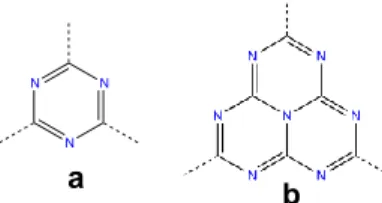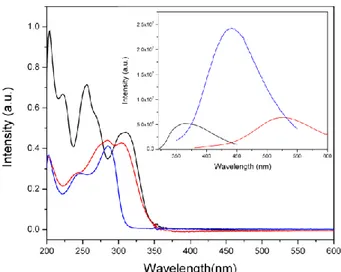1
Trinuclear Cu
II
Complex with Functionalized
s-Heptazine N-ligands: Molecular Chemistry from a
g-C
3
N
4
fragment
Lindley Maxwell,
aSilvia Gómez-Coca,
a* Thomas Weyhermüller,
bDavid Panyella,
cEliseo Ruiz
a*
A new kind of N-ligands based on heptazine derivatives is
presented. A trinuclear CuII complex,
[(L)2CuII3Cl3](ClO4)3·3CH2Cl2 (L=2,5,8-tris-(di-2-pyrildylamine)
heptazine), utilizing a pyridine derivative of heptazine has been synthesized and characterized avoiding the inherent solubility problems of heptazine compounds. Thus, this work opens the application of such ligands either in supramolecular chemistry as a larger ligand of the widely used s-triazine derivatives or to provide molecular systems for photocatalysis as heptazine is the fundamental unit of the very promising g-C3N4 2D compound.
1,3,5-Triazine (s-triazine) derivatives (see Fig 1a) have been extensively employed in Chemistry, from pharmaceutical, textile, plastic, and rubber industries, and are used as pesticides, dye stuffs,
optical bleaches, sun filters, antioxidants, explosives, and
surface-active agents.1 Furthermore, it is worth noting a widespread use in
fundamental chemistry as metal ligands in supramolecular systems
(more than 2600 structures containing the s-triazine moiety in CSD).2 Some derivatives like melamine, cyanuric acid and cyanuric chloride are known since the pioneering work of Liebig published in 1834.3,4 This publication also contains the description of s-heptazine, also called tri-triazine or ciamelurine (see Fig. 1b). However, s-heptazine derivatives have been considerably less employed in chemistry which is reflected by the fact that there are just about 61 structures with this fragment (only eight with transition metals with extended structures) in the CSD database (v. 5.36, Feb. 2015). One of the main reasons for such difference is the low solubility of s-heptazine derivatives that results in the difficulty to develop a rich chemistry based on this building block. Up to now, the transition metal complexes with such fragment have been synthesized by solid-state techniques with carboxylate substituents, in order to avoid solubility problems and to synthesize coordination polymers.5,6 It is remarkable that the ability of the polymeric derivative of s-heptazine, also graphitic carbon nitride (g-C3N4), has been used for the catalytic photodecomposition of water and also for some photocatalysed alkane and alcohol oxidation reactions.7,8 The goal of
this paper is to show that it is possible to overcome solubility problems of heptazine derivatives and to synthesize well defined transition metal complexes which might show some similar physical, photophysical or catalytic properties as the less well defined heterogeneous g-C3N4 compounds. This approach can open a promising field of new applications using heptazine derivatives as common building blocks that can surpass the chemical and physical properties of the equivalent s-triazine system due to a larger size of the system.
Fig. 1 (a) s-triazine and (b) s-heptazine chemical groups.
To this end, the synthesis of the ligand is indicated in Fig. 2. The first step requires to pyrolysis of urea at high temperature to obtain the polymeric [C6N7(NH)(NH2)]n melon 1 (hydrogenated g-C3N4). The urea precursor shows many advantages to the KSCN decomposition used in the earlier studies.9 The next step is an alkali hydrolysis to obtain the trialkoxido derivative 2 that can react in the solid-state phase with PCl5 to obtain the trichloro derivative 3 (usually called cyameluric chloride). The substitution reaction with amines to obtain the ligand 4 (L : 2,5,8-tris-(di-2-pyrildylamine) heptazine) was previously described as a two step synthesis. First a reflux of dipyridylamine (dpa) with 3 (6:1 molar ratio) in xylene followed by an extraction with hot chloroform and recrystallization from large amounts of ethyl acetate to obtain the disubstituted derivate. The second step is a reflux of dpa with the disubtituted derivate (3:1 molar ratio) in sodium-dried decaline under nitrogen.10 In an attempt to directly obtain the derivate 4 we performed the synthesis in a similar way to that of the triazine derivate,11 a reflux of dpa with 3 (6:1 molar ratio) in toluene. Several days of reflux leads to a low yield of about 20%.
COMMUNICATION
Journal Name
2
Fig. 2 Reaction steps in order to synthesize the ligand L (mw: microwave).
A modified approach using microwave assisted reaction provides a satisfying yield of more than 70% in less than 15 minutes of reaction time and with a smaller molar ratio (see ESI). The crude product was througly washed with acetone and 1H NMR analysis confirmed that a succesful synthesis of 4 was achieved. A second substantial improvement is the use of a 1:1 mixture of CH3OH/CH2Cl2 as solvent for the ligand which is highly insoluble in pure solvents. In a similar way than previously described for the triazine derivate ((2,4,6-tris(di-2-pyrildilamine)-1,3,5-triazine))12, the reaction of 4 with a stoichiometric 1:1 mixture of CuCl2·2H2O:Cu(ClO4)2·6H2O in solution (CH3OH/CH2Cl2) yield single-crystalline blue material of the trinuclear complex 5 upon cooling to 5°C. (see Fig. 3, X-ray diffraction details as ESI).
Fig. 3 Two representations of the structure of complex 5 [Cu3Cl3(L)2](ClO4)3·3CH2Cl2. Green, blue, black, yellow and red ellipsoids correspond to copper, nitrogen, carbon, chlorine and oxygen atoms, respectively.
Complex 5, shows no significant exchange interactions between CuII centers (see Magnetic measurement section in ESI). This fact is mainly due to the large distance between the magnetic centers and the ortogonal alignment of the magnetic dx2-y2 orbital of the CuII centers with the system of the central heptazine.(see Fig. S5) The distance between the two C6N7 centroids of the heptazine moieties of 3.469 Å is about 0.5 Å shorter than the analogous s-triazine system,12 probably due to the larger size of the system resulting in stronger - interactions. It is worth noting the presence of a
relatively strong anion- two
perchlorate counteranions (see Fig. 3 and ESI). One of the perchlorate anions shows a remarkable Cl···ring (O···ring) distance of 3.313 (2.687) Å considerably shorter than in the analogous complex with the s-triazine based ligand which is at 3.695 (3.118) Å.2
The photochemical properties of the ligand 4 (and the comparison with the analogous triazine ligand) and trinuclear complex 5 are rather noteworthy (see Fig. 4). From these data, we can outline some points: (i) the heptazine-based ligand 4 has a higher absorbance than the analogous complex with triazine (with extinction coefficients of 5.2·104 and 5.1·104 M-1cm-1, respectively and 6.0·104 M-1cm-1 for the complex) while the emission is significantly stronger in the triazine ligand. Hence, deexcitation processes through non-radiative mechanisms are more effective in heptazine ligands that can be relevant in applications as sunscreen systems. Taking into account that many widely employed commercial products are based on triazine derivatives. (ii) The quenching effects in the [Cu3Cl3(L)2](ClO4)3 complex are relatively weak showing an emission intensities similar to that of the free ligand. Thus, the complex 5 shows a remarkable photochemical property with a strong emission in the UV region. (iii) the Stokes shift of the [Cu3Cl3(L)2](ClO4)3 complex is rather small (around 50 nm) while in the free 4 ligand is more than 200 nm. This fact is probably due to the intramolecular charge transfer process (see Fig. S9) caused by the absorption that will result in an important structural change in the excited state of the molecule. Such structural variations can lead to the existence of new lower-energy excited states that should be the responsible of the red-shift in the emission maxima.
Fig. 4 Absorption and emission (inset) spectra of ligand 4 (red), the related s-triazine ligand (blue) and the complex 5 (black). The solutions were 8·10-6 M in CH3OH (see data for other concentrations and excitation spectra as SI) and the excitation wavelengths are 308, 284 and 305 nm for ligand 4, triazine equivalent ligand and complex 5, respectively.
Journal Name
COMMUNICATION
3
As summary, we would like to highlight the possibility to perform conventional solvent chemistry with heptazine derivatives to obtain new N-ligands and metal complexes. Previously reported, metal compounds with heptazine based-ligands were synthesized by solvothermal methods and they contain carboxylate groups for the coordination with the metal centers.5,6 Thus, such an approach opens a wide range of possible applications in comparison with equivalent triazine systems that are extensively employed in many research area of Chemistry.
Financial Support by the Ministerio de Ciencia e Innovación through grant CTQ2011-23862-C02-01. E.R. thanks Generalitat de Catalunya for his ICREA Academia grant. L.M. thanks Conicyt-Chile for a predoctoral fellowship. We thank the CSUC for computational resources
Notes and references
a Departament de Química Inorgànica and Institut de Recerca de Química Teòrica i Computacional, Universitat de Barcelona, Diagonal 645, 08028 Barcelona, Spain.
b Max-Planck-Institut für Chemische Energiekonversion, Stiftstr. 34-36, 45470 Mülheim an der Ruhr, Germany
c Antonio Puig SA, Potosi 21, 08030 Barcelona, Spain
‡ Electronic Supplementary Information (ESI) available: Details of synthesis and characterization (IR data, mass spectra, NMR). Magnetic measurements, DFT calculations and crystallographic data, CCDC-1057494 contains the supplementary crystallographic data for trinuclear complex. These data can be obtained free of charge via http://www. ccdc.cam.ac.uk/conts/retrieving.html or from the Cambridge Crystallographic Data Centre, 12 Union Road, Cambridge CB2 1EZ, UK; fax: +44 (0) 1223−336−033; or e-mail: [email protected]
1.G. Giacomelli, A. Porcheddu and L. De Luca, Curr. Org. Chem., 2004, 8, 1497-1519.
2.F. H. Allen, Acta Crystallogr. B, 2002, 58, 380-388. 3.J. Liebig, Ann. Pharm., 1834, 10.
4.A. Schwarzer, T. Saplinova and E. Kroke, Coord. Chem. Rev., 2013, 257, 2032-2062.
5.Y. Ke, D. J. Collins, D. Sun and H.-C. Zhou, Inorg. Chem., 2006, 45, 1897-1899.
6.S. Ma, D. Sun, M. Ambrogio, J. A. Fillinger, S. Parkin and H.-C. Zhou, J.
Am. Chem. Soc., 2007, 129, 1858-1859.
7.X. Wang, K. Maeda, A. Thomas, K. Takanabe, G. Xin, J. M. Carlsson, K. Domen and M. Antonietti, Nature Mat., 2009, 8, 76-80.
8.Y. Wang, X. Wang and M. Antonietti, Angew. Chem. Int. Ed., 2012, 51, 68-89.
9.J. Liu, T. Zhang, Z. Wang, G. Dawson and W. Chen, J. Mater. Chem., 2011, 21, 14398-14401.
10.H. Schroeder and E. Kober, J. Org. Chem., 1962, 27, 4262-4266. 11.J. Pang, Y. Tao, S. Freiberg, X.-P. Yang, M. D'Iorio and S. Wang, J. Mat.
Chem., 2002, 12, 206-212.
12.L. A. Barrios, G. Aromí, A. Frontera, D. Quiñonero, P. M. Deyà, P. Gamez, O. Roubeau, E. J. Shotton and S. J. Teat, Inorg. Chem., 2008, 47, 5873-5881.

